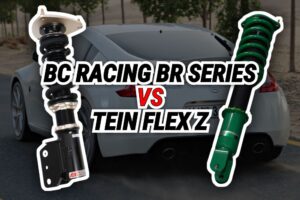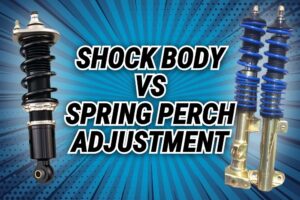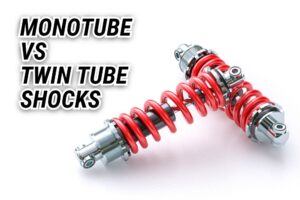How to Choose the Right Coilovers For Your Car
Choosing the right coilovers for your car is like picking the best shoes for a specific activity. Just like you wouldn’t put on hiking boots for a marathon, you should pick coilovers that match your car’s usage and performance needs.
There are many factors to consider, such as the spring rate, type of dampers and how much you can adjust the coilovers. But how do you make the right choice among all these options? In the post we will cover what you need to know when selecting coilovers.
Features to Consider When Choosing Coilovers
Budget
The budget is going to be the biggest deciding factor when purchasing coilovers. No point deciding on a set that costs 3x what you have to spend.
The price of coilovers can vary widely, from as low as $500 to $5000 or more, depending on the brand and specs.
Low-cost coilovers might be cheaper at first, but you’ll probably have to replace them sooner. And they’ll offer a worse ride and handling performance.
On the other hand, high-end coilovers perform better and last longer, but they cost more.
Don’t just look at the initial cost. Consider the long-term value and what you are really getting. Take some time to look into different options. You want to find a good balance between the cost and quality that works for your needs.
The best coilovers for you’re the ones that give you the performance you want at a price you can manage.
Height Adjustment By Shock Body Or Spring Perch
When picking coilovers for your car, you need to decide between height adjustment by shock body or spring perch. Coilovers with shock body adjustment allow you to adjust the height without affecting the damper’s travel range, which is beneficial if you plan on going a lot lower than factor.
Adjustment by spring perch, on the other hand, means you a lowering where the spring sits in relation to the damper to lower the car. This means the lower you go, the less travel you have, and the higher the chance of bottoming out which can blow your dampers if it happens too often.
Most coilovers on the market today allow shock body adjustment, but some brands like KW still offer spring perch adjustment.
Monotube Vs Twin Tube Damper Type
When choosing coilovers for your car, you’ll need to decide between monotube and twin tube damper types. Monotube dampers are often the preferred choice for better performance. They’re designed to manage heat well and respond quickly. This means they can react fast to changes in the road.
On the other hand, twin tube dampers have a different setup. They use two tubes to keep the oil and gas separate. Twin tubes are typically selected for better ride comfort, making them a good choice for street use.
If you want to upgrade your car for both regular street driving and track racing, monotube dampers are usually better. They’ve a bigger piston and a single-tube design. This makes them more efficient and better for dealing with different road conditions.
Linear Vs Digressive Valving
The type of valving in the dampers is also important to consider when picking coilovers for your car.
Linear valving means the dampening increases in proportion to the piston speed, making for a predictable damping response. This makes linear dampers a popular choice for street setups as they tend to be more comfortable, however they have their place on the track as well.
Digressive valving, however, starts off with a stiffer damping rate, and then tapers off as the piston speed increases. The benefit of this is that it gives a more stable feel, and allows you to run stiffer low piston speed damping while high piston speed damping (such as bumps or curbs) is not as stiff, removing the negatives of very high damping at high piston speeds.
This makes digressive valving popular in many forms of motorsport, but means less comfort.
What you should choose depends on how you plan to use your car and what kind of suspension you want. Knowing these things helps ensure your car handles well and is comfortable to drive.
But to make things simple, if this is your first coilover set and you are primarily using the car on the street, linear damping will be more than good enough. If you need help, don’t be shy to send us an email.
Rubber Vs Pillowball Top Mounts
Another decision you’ll need to make is choosing between two types of top mounts for your coilovers: rubber and pillowball.
Rubber top mounts are more for comfort as they absorb energy, making for a softer ride and eliminating the harshness of bumps and vibrations. However, they allow for more suspension movement, which can negatively impact handling performance.
Pillowball top mounts, on the other hand, have metal bearings and give a more accurate steering feel, making for more predictable and consistent handling. However, they do let more vibrations through, which will make the car less comfortable on the street.
It’s important to pick the top mount that matches your driving needs and what you find comfortable.
Camber Adjustment
Some top mounts (on cars with MacPherson struts) come with camber adjustment. This feature lets you adjust the camber angle of your car’s wheels, which can improve your car’s grip on corners, change tire wear, and how well it handles. Usually camber adjustable top mounts will be pillowball, though some brands like RS*R have rubber camber adjustable top mount options.
This is mainly necessary on cars that will see track time, or if you have specific wheel fitment requirements.
Spring Rates
When picking coilovers for your car, it’s vital to think about spring rates. This is because they play a big role in how your car rides and performs. Your car’s weight and how you want it to handle should guide your choice in spring rates.
If you go for high spring rates, they can reduce body roll and improve handling. However, they will make the ride more harsh.
On the other hand, lower rates give a softer ride, but might affect performance and allow more body roll.
The spring rate shapes how your car’s suspension deals with bumps and turns, which directly impacts ride comfort. So, it’s key to find a balance between performance and comfort that fits your driving style and suspension setup.
Most coilovers come with a standard spring rate designed with a balance in mind. So if you are unsure, sticking to standard spring rates is usually the best way to go.
One, Two or Three Way Dampening Adjustment
It’s also crucial to think about the kind of dampening adjustment your coilovers have. This will impact what control you have over the coilovers’ damper settings.
With one-way dampening adjustment, you get basic control, usually adjusting both compression and rebound together (though some kits like Fortune Auto only offer rebound adjustment on their 1-ways).
Upgrading to two-way dampening gives you separate control over compression and rebound, providing better tuning options.
For the most precise control, think about three-way dampening. This adds high-speed compression adjustment to the two-way setup.
Keep in mind your driving style and suspension needs when choosing. In most cases, 1 way adjustment is more than enough unless you are chasing milliseconds at the track.
Consider What the Car Will Be Used For
It’s important to consider what you’ll use your car for before picking the right coilovers. If you’ll use it for daily driving, racing on a track, or for a very low ride, each use will need a different set up.
Best Coilovers For Street Use
The best coilovers for street use typically have the following specs:
- Standard spring rates on the softer side
- Twin tube or monotube dampers with linear valving
- Rubber top mounts
- 1 way dampening adjustment
- Corrosion resistance
- Warranty
Best Coilovers For Track Use
For track use, you typically want coilovers with the following specs:
- Stiffer spring rates with matched dampers
- Monotube dampers with digressive valving
- 2 or even 3 way dampening adjustment
- Pillowball top mounts with camber adjustment (on MacPherson strut models)
Best Coilovers For Low
If you want to go super low, there are a couple of things you should look for:
- Stiffer springs with matched dampers
- Shorter shock bodies and dampers
- Height adjustment by shock body
- Camber adjustment (if applicable)
If your goal is to go as low as possible, you might want to consider a kit like BC Racing Extreme Low, Silvers Super Lows or RS*R Black*I.
Conclusion
Selecting the best coilovers for your car requires understanding what they do, identifying your car’s needs, and comparing different features. You need to think about aspects like spring rate, adjustability, and compression/rebound settings. If you need help selecting the right coilovers for your car, be sure to contact us and we will help you get the right setup.
- BC Racing BR Series VS Tein Flex Z Coilovers - April 15, 2024
- The Pros and Cons of Shock Body Vs Spring Perch Coilover Height Adjustment - April 13, 2024
- Monotube Vs Twin Tube Shocks: The Ultimate Guide - April 11, 2024



